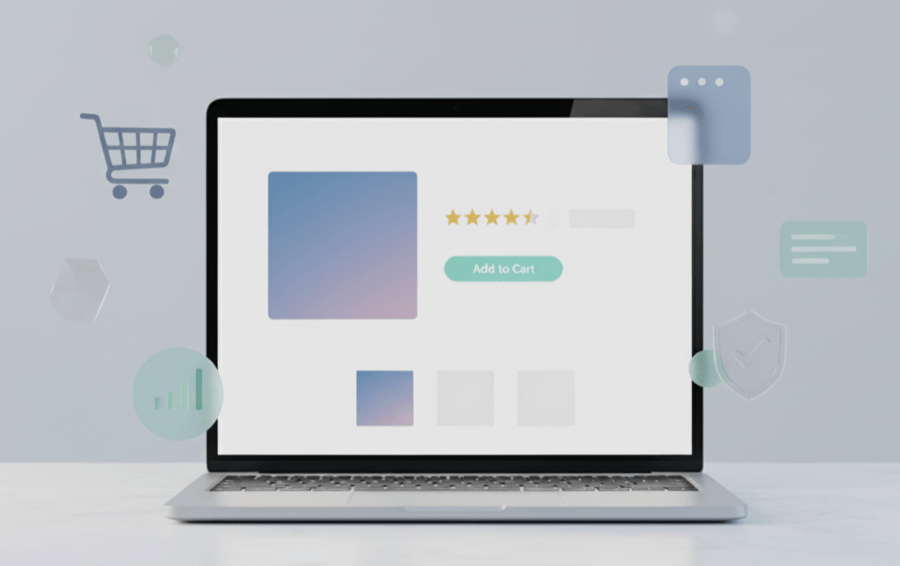Product Page SEO: How to Build Pages That Rank and Convert

Last Updated on 18 November 2025 by Dorian Menard
Product page and ecommerce SEO isn’t about rankings alone—it’s a revenue-driven system. Integrate strategic keywords, persuasive content, technical SEO, and trust signals to convert visitors into customers. Rich snippets boost CTR, high-quality visuals enhance trust, and structured data improves visibility.
Are your product pages attracting visitors but failing to convert them into buyers? Many e-commerce businesses overlook how product page SEO impacts sales performance, missing revenue opportunities.
This comprehensive guide shows how to build high-ranking and converting product pages using strategic keywords, persuasive content, technical optimizations, and trust elements like reviews and schema markup.
Enhance UX with high-quality visuals, concise descriptions, mobile optimization, and internal linking to boost rankings, reduce cart abandonment, and maximize your e-commerce ROI. Discover proven tactics to turn browsers into buyers with data-driven SEO strategies that deliver measurable sales growth and profitability.
- Why Your Product Pages Aren’t Making Money (And How to Fix It)
- Laying the Groundwork: Strategic Keywords and On-Page Fundamentals
- Beyond the basics: content and UX that convert visitors into customers
- The Technical Engine: Schema, Speed, and Site Structure
- Advanced Strategies for Complex E-commerce Sites
- From data to dollars: auditing and measuring your success
Why Your Product Pages Aren’t Making Money (And How to Fix It)
High traffic but low sales? Your product pages may be failing to convert visitors. Empty calendars and silent phones indicate wasted marketing spend. Traffic without conversion is a costly mistake. For instance, a Perth-based business with high traffic but unoptimized product pages loses customers to competitors who provide clear information and trust signals.
Many businesses target broad keywords, attracting browsers instead of buyers. Poor descriptions, slow load times, and unclear CTAs drive visitors away. Mobile responsiveness is critical for UX and SEO. Pages that load slowly increase bounce rates and hurt rankings.
Product page SEO isn’t about rankings—it’s revenue-focused.
- Optimize for transactional keywords like ‘buy [product]’ or ‘best [product] near me’ to attract ready-to-purchase customers.
- Highlight benefits, not just features—e.g., ‘water-resistant watch for daily adventures’ instead of ‘stainless steel case’.
- Add trust signals: verified reviews, payment badges, money-back guarantees.
- Ensure mobile speed and clear navigation.
- Include structured data for rich snippets, which display prices and availability directly in search results.
The #1 result gets 10x more clicks than #10. Without conversion elements, traffic won’t sell. Focus on user intent: clear CTAs like ‘Add to Cart’ in high-contrast colors, high-quality images with zoom functionality, and detailed product specs to reduce hesitation.
Optimizing product pages boosts conversions and reduces cart abandonment. FAQs address common questions like shipping times or return policies, building trust. For local businesses, include location-specific details to attract nearby customers. Start now to maximize ROI.
Laying the Groundwork: Strategic Keywords and On-Page Fundamentals
Effective product pages start with transactional keywords that signal purchase intent. These terms, such as “buy men’s waterproof trail running shoes size 11”, target users ready to convert rather than just researching.
Choosing 3-5 precise long-tail keywords minimizes competition while attracting highly qualified traffic. This strategy ensures your page ranks for searches with high conversion potential, not just high volume.
Target Keywords With Clear Buying Intent
Transactional keywords signal strong purchase intent. Users searching these terms are in the decision phase, making them 3x more likely to convert than informational query users. Use modifiers like “buy”, “price”, or “near me” which indicate commercial intent.
Tools like SEMrush or Ahrefs can filter keywords by intent. Example: “men’s waterproof trail running shoes size 11” targets specific needs with less competition than generic terms.
Answering common questions like “how to clean X product” in your content captures additional voice search traffic and improves relevance. Local modifiers like “near me” help businesses capture nearby customers searching for immediate solutions.
Craft Titles and Meta Descriptions That Demand a Click
Title tags and meta descriptions are critical for CTR in search results.
Keep titles under 65 characters. Meta descriptions should be 130-160 characters, clearly stating the product’s key benefit and urgency.
Example: “Buy Waterproof Trail Running Shoes | Free Shipping & 30-Day Guarantee | Size 11”.
Test variations using Google Search Console data to maximize clicks. Urgency cues like “Limited Stock” or “24h Delivery” drive immediate action from potential buyers, reducing bounce rates.
Well-structured snippets directly impact organic traffic quality by attracting qualified visitors.
Write Unique Product Descriptions That Sell
Avoid duplicate content at all costs. Copying manufacturer descriptions dilutes SEO value and confuses buyers, directly impacting your ability to rank and convert. It can even get you suspended for misrepresentation if you use merchant centre and run Google Shopping Ads!
Focus on benefits, not just features. Explain how the product solves real problems using your audience’s language. Answer size, compatibility, and care questions upfront.
For example: “Stay dry on rainy trails with our waterproof, breathable design” or “Machine washable for easy maintenance”. Include a clear CTA like “Add to Cart Now” or “Shop Today for 24h Delivery”.
Custom descriptions build trust, avoid duplicate content penalties, and improve SEO performance. You have no excuse in 2025 and beyond as AI makes it dead simple to generate unique and quality descriptions at scale over thousands of products!
Well-structured content increases average order value by helping customers visualize the product’s value. Integrate schema markup for product details to display star ratings and pricing in search results, enhancing visibility and trust.

Beyond the basics: content and UX that convert visitors into customers
Use high-quality images and video to showcase your product
High-quality images and videos replace physical interaction, building confidence when customers can’t touch products. Optimize filenames, alt text, and multiple angles for SEO visibility.
Compress images with WebP and TinyPNG for speed. Mobile commerce dominates retail by 2025, so fast load times are critical. PayPal’s research shows fast visuals convert mobile users; slow pages lose 40% of visitors.
Videos showcase products with close-ups and usage scenarios. Keep them concise for quick loading, reducing returns and boosting conversions.
Build unbreakable trust and create urgency
97% of shoppers read reviews before buying. Display verified testimonials above the fold. Photo reviews boost conversions by 69%, building trust faster than product descriptions.
Place trust badges like ‘Norton Secured’ near checkout. Social proof like ’57 sold today’ creates urgency. Real-time stock counters reduce hesitation ethically.
Limited stock alerts prompt action. Real-time counters create genuine urgency, boosting conversions without harming credibility.
Leverage a powerful FAQ section
A well-structured FAQ page is critical in the era of AI SEO!
Use them to addresse shipping, returns, and compatibility. Integrates long-tail keywords for SEO, reducing support queries and guiding purchases.
Google restricts FAQ schema for e-commerce, but content improves UX. Base FAQs on customer inquiries to prevent cart abandonment. Use tools like SEO minions, Answer The Public or Also Asked to find questions relevant to your niche.
Address sizing, shipping, and returns. Examples like ‘Will this fit my phone?’ preempt hesitations. Clear answers increase conversions and trust.

The Technical Engine: Schema, Speed, and Site Structure
Implement Product Schema for Standout Rich Results
Product Schema acts as a translator between your site and search engines. It ensures accurate interpretation of product details. Without it, search engines may miss critical information.
Implementing Product Schema isn’t just a technical task; it’s a direct line to enhanced visibility in the SERPs, turning standard listings into rich, clickable results with ratings and pricing.
Key properties include name, image, description, price, and availability. These elements create rich snippets that stand out in search results.
Merchant listings and Product snippets both benefit from structured data. Providing detailed attributes maximizes your chances of appearing in Google Shopping and other rich results.
Missing schema means your products stay invisible in enhanced SERP features. This directly impacts click-through rates and qualified traffic.
For example, products with aggregateRating display star ratings, which can increase CTR by up to 30% compared to plain listings.
Include properties like sku, mpn, gtin, and brand for comprehensive data. This helps Google understand and showcase your products accurately and is a requirement to avoid merchant center suspensions.
Optimize Page Speed to Keep Users and Google Happy
Page speed directly affects rankings and user experience. Google uses Core Web Vitals like LCP and CLS to measure performance.
- 63% of users abandon sites taking over 4 seconds to load. Mobile conversions drop by up to 22% without optimization.
- A 1-second delay can reduce mobile conversions by 3%. Sites loading in 2.4 seconds have a 1.9% conversion rate versus 0.6% for slow pages.
- Optimize images with compression and WebP format. Minify code and enable browser caching for faster loads.
- Walmart improved conversions by 2% with a 1-second speed increase. COOK boosted conversions by 7% by reducing load time by 0.85 seconds.
Use tools like PageSpeed Insights and GTmetrix to identify performance bottlenecks. Fix issues immediately to retain visitors.

Guide Users and Crawlers with Smart Internal Linking
Internal linking guides users to related products and spreads SEO authority across your site. This improves engagement and helps search engines index pages.
Experts recommend avoiding page numbers in breadcrumbs. It can create unhelpful rich snippets and confuse search algorithms.
Read expert advice on breadcrumb structure.
Link to category pages and “Customers also bought” sections. Use descriptive anchor text for better context.
Ensure all links are dofollow and relevant. Avoid excessive links that dilute value.
Breadcrumbs should reflect user paths, not just URL structure. Use JSON-LD for structured data to ensure proper display.
Link from high-authority pages like category pages to product pages. This transfers SEO value and improves rankings.
Follow a comprehensive ecommerce SEO checklist for optimal structure.
Advanced Strategies for Complex E-commerce Sites
Solve Product Variant and Cannibalisation Issues with Canonicals
Multiple product variant pages competing for the same keywords split SEO authority. This causes inconsistent rankings and confuses search engines.
- Implement rel=”canonical” tags to consolidate signals. Point all color or size variants to the main product URL. This ensures Google indexes the correct page.
- Google recommends Schema.org ProductGroup for structured data. Grouping variants improves visibility in shopping results and product carousels.
- Product cannibalization can reduce click-through rates by 30%. Fixing it immediately protects your rankings and revenue.
- Many sites use self-referencing canonical tags. This does not solve cannibalization. Always point to the main product page.
- Check Google Search Console for overlapping rankings. If multiple product pages appear for the same query, fix it immediately.
Master the Lifecycle: Handling Out-of-Stock and Discontinued Items
| Strategy | When to Use It | SEO Impact |
|---|---|---|
| 301 Redirect | Product permanently discontinued with a similar alternative | Passes 90%+ link equity; maintains UX and rankings |
| 404/410 Status | No replacement available | 410 signals intentional removal; speeds up deindexing |
| Keep Page Live | Temporary stock issues or valuable backlinks | Retains ranking power; use clear out-of-stock notices |
A 301 redirect preserves 90% of link equity for discontinued products. Redirect to a similar item or category page.
Keeping pages live for temporary stock maintains rankings. Use clear out-of-stock notices and email alerts for restocks.
410 status is better than 404 for permanent removal. It speeds up deindexing and signals clear intent to search engines.
Ignoring product lifecycle management risks losing 40% of traffic. Immediate action protects revenue streams.
For products with high backlinks, always redirect 301 to preserve SEO value. Deleting pages without redirects kills rankings.
Avoid deleting product pages without redirects. This kills SEO equity and loses customers permanently.
From data to revenue: auditing and measuring your success
Focus on Metrics That Matter for Your Bottom Line
Stop chasing rankings. Track revenue-driving KPIs like conversion rate, AOV, and cart abandonment. Conversion rates over 5% indicate strong trust signals; a 1% increase can boost revenue by 10%+.
AOV grows via upselling complementary products—for example, a $15 accessory with a $50 product boosts AOV by 30%. Cart abandonment above 70% signals checkout friction; fix hidden fees, simplify forms, and implement transparent pricing to recover 15-30% of lost sales. A/B testing checkout flows reduces abandonment by up to 25%.
RPV (AOV × conversion rate) guides budget allocation; $5 RPV equals $500 revenue per 100 visitors. ROAS calculations prioritize high-performing channels; target a 4:1+ ratio to generate $4+ revenue per $1 spent. Use Google Analytics 4 for real-time tracking and custom conversion goals.
How to Conduct a Product Page SEO Audit
Run monthly audits. In Google Search Console, check high-impression, low-CTR queries and technical issues. Validate schema markup with Rich Results Test. Optimize meta titles (50-60 chars) and descriptions (150-160 chars) with target keywords. Compress images and enable lazy loading for sub-3s load times.
Performing a site audit uncovers hidden technical issues and content gaps. Fix broken links, duplicates, and canonical tags. Ensure unique product descriptions to avoid cannibalization. Check hreflang tags for international targeting. Address 4xx/5xx errors promptly.
Test Core Web Vitals and mobile responsiveness using Lighthouse—aiming for scores above 90. Heatmaps reveal drop-off points, optimizing CTAs for higher engagement. Regular audits maintain rankings and conversions year-round.
Turn your product pages into revenue drivers
Product page SEO is a strategic system where technical, content, and UX elements work together to drive revenue. It’s not a checklist—it’s a business strategy focused on converting visitors into buyers.
Target transactional keywords and create detailed, original product descriptions highlighting benefits over features. Optimize images with descriptive alt text and compress for speed. Implement structured data for rich snippets and Google Shopping. Include customer reviews and FAQs to answer common questions and build trust.
Ensure fast loading times, mobile responsiveness, and clear CTAs like ‘Add to Cart’. Optimize meta titles and descriptions for higher click-through rates. Use internal links to related products and showcase trust badges for secure payments. Conduct regular audits to fix broken links and improve site speed. Use urgency tactics like low stock alerts to drive immediate action.
If you’re ready to stop relying on ads and turn your website into a consistent source of sales, our online store ecom services are designed to deliver measurable ROI. Let’s build product pages that don’t just rank, but sell.
Product page SEO isn’t about rankings—it’s about revenue. Integrate technical precision, compelling content, and seamless UX to convert visitors into buyers. Ready to transform your store? Our online store ecom services deliver measurable ROI. Let’s build pages that don’t just rank, but sell.
FAQ
How can I prevent SEO cannibalization when managing product variants?
Product variants can cause keyword cannibalization if multiple pages target the same terms. This splits SEO authority and hurts rankings.
Implement canonical tags pointing to the main variant page. For example, set the primary color’s URL as canonical for all color variations. Consolidate ranking signals and avoid internal competition. Learn more about comprehensive SEO strategies in our e-commerce SEO checklist.
What’s the best way to handle out-of-stock product pages for SEO?
Keeping the page live with a clear “out of stock” message preserves SEO value and maintains backlinks. Add a “notify me when available” feature to capture potential buyers.
Avoid 404 errors or immediate redirects unless the product is permanently discontinued. For permanent removal, use a 301 redirect to a relevant category or similar product page. Detailed guidance on managing product availability can be found in our site audit guide.
How does page speed affect conversion rates on product pages?
Page speed directly impacts conversions. Studies show that a 1-second delay can reduce conversions by up to 7%. For example, Walmart found a 2% conversion increase per second of improvement.
Core Web Vitals like LCP and INP are critical metrics. Optimize images, leverage browser caching, and use a CDN to ensure sub-2-second load times. Faster pages also improve SEO rankings, creating a dual benefit for traffic and sales. Learn more about product page optimization from PayPal’s research.
Why should I use schema markup for product pages?
Schema markup helps search engines understand your product details, leading to rich snippets like star ratings and prices in SERPs. This boosts visibility and click-through rates.
Implementing Product Schema with properties like aggregateRating and price increases the chances of appearing in Google Shopping results. Proper structured data also enhances accessibility for voice search and other AI-driven platforms. For best practices, refer to Google’s official guidelines on structured data for products.
What trust signals should I include on product pages to increase conversions?
Trust signals like SSL badges, customer reviews, money-back guarantees, and payment method logos build credibility. Displaying real-time stock counts or “only X left” creates urgency.
Testimonials from verified buyers and industry awards further reassure customers. These elements reduce purchase anxiety and directly impact conversion rates.